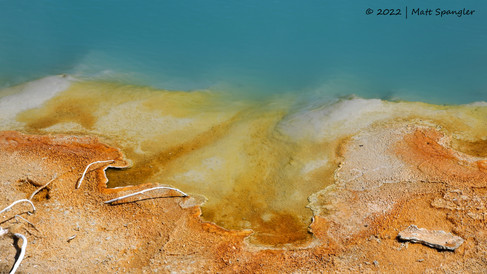Yellowstone Day Trip
- Matt Spangler
- Jun 23, 2022
- 6 min read
The fourth day of a weeklong vacation in Montana—detailed in this separate blog post—involved a day trip to Yellowstone. My wife and I were joined by the two friends (Charlie and Sara) we were staying with in Montana. The adventure was packed full of geological and mammalian wonders, the likes of which my wife and I had never seen before.

Torrential flooding a week or two before our trip washed out several roads and bridges within Yellowstone, leading to a temporary total closure of the park. We visited on the second day of the park’s reopening. Only the southern loop was accessible, and they let in about half the people as normal. This actually worked out pretty well for our day trip.
Our home base near Ennis Lake was only an hour and a half from Yellowstone’s west entrance. Once within the park, we covered a lot of ground: the entire south loop, starting at the west entrance and proceeding through Madison, to West Thumb, to Fishing Bridge, to Canyon, to Norris, and back out via Madison and West Yellowstone. We were basically in the car all day, with frequent stops and several short hikes. We were on the lookout for mammals throughout the drive; Sara took the prize for best spotter.
The entrance road paralleling the Madison River was gorgeous. The drive introduced us to two facts about Yellowstone: (1) Bison are everywhere, and (2) Lodgepole Pines are everywhere (we saw few other trees in the entire park). While on the entry road, we also saw a Mule Deer and some Sandhill Cranes that resembled mammals at a distance.
We stopped at a variety of geyser basins on the road south of Madison. I had never seen any type of geothermal activity and found this section of the trip particularly awe-inspiring. It wasn’t just geysers (we saw a few small ones); the diversity of geothermal features, with varying sizes, shapes, colors, etc. made me forget I was on planet earth. I wish I was more poetic, but hopefully my pictures capture some portion of the grandeur we experienced.
Our first quick stop in the geyser valleys featured a dust-covered Bison, a singing Savannah Sparrow, and a long-distant geyser.
We skipped over areas that were overflowing with tourists, including Fountain Paint Pot and the boardwalk around Grand Prismatic Springs. Our first “real” stop was Midway Basin, where we hiked a trail leading to an overlook of Grand Prismatic. The bustling crowds vexed me, but the view was worth it. We saw a bunch of Bison in this general area; one was foraging 20 feet from our parked car as we (cautiously) returned from the hike.
Next up was the Biscuit Basin, which we affectionately dubbed Biscuitville. One of the trailheads was closed (it opened just as we left); this apparently deterred all but a half dozen other visitors. Especially after the Midway Basin experience, this was like leaving a city and breathing fresh, wild air. This was my favorite stop of the trip, not only because we had the boardwalks almost to ourselves, but also because of the diverse geothermal activity. Biscuitville’s thermal attractions were framed on one side by the Firehole River and on the other by rocky hills. The area featured at least 20 otherworldly springs in every shape, size, and color—from deep blue caverns to aquamarine pools with yellow and orange margins, to sinister red and brown seeps, all contrasting against the bone white ground.
A mix of colorful thermophilic bacteria and mineral deposits made fantastic patterns in the shallows.
Biscuitville was also home to a "small" geyser that erupted about every 5 minutes. It was interesting to hear the water bubbling up to the surface just before eruption.
Although the geology was the key attraction at Biscuitville, wildlife provided a few nice distractions. We saw a chipmunk (probably Yellow-Pine, but possibly Least), some Red Squirrels, and an Anise Swallowtail (a lifer). A flyover Red Crossbill was the most exciting bird here.
After Biscuitville came Black Sand Basin. This set of boardwalks featured another dazzling array of geothermal features. Blue mist rising off a large spring water made an interesting contrast to the orange-red bacterial waterfall that coated the white slopes down to Iron Spring Creek. The best bird here was a Violet-green Swallow (spotted by my wife).
As we continued south, we skipped Old Faithful, and that was a good decision—too many people. I’d like to visit on another trip, perhaps if we overnight in the park and arrive for sunrise. It was lunchtime by the time we stopped at Kepler Cascades; we settled down for a picnic just upstream of the waterfall. I managed to hear two Cordilleran Flycatchers (lifers) over the sound of rushing water, and I got distant looks at one on the other side of the conifer-covered gorge. I also got photos of three lifer butterflies: Green Comma, Hoary Comma, and Thicket Hairstreak.

After lunch, we continued around the loop, crossing the continental divide once, and then back again. Despite temperatures in the 70s, we drove by several patches of snow remaining in the shady forests. Once we got near the West Thumb Geyser Basin, we briefly stopped for some Elk and a Coyote. Then, we joined a steady (but bearable) stream of people hiking the boardwalks. This particular geyser basin is nestled against the west shore of the massive Lake Yellowstone, and featured even more types of geothermal features, including some that were underwater. Another Red Crossbill and an approachable White-crowned Sparrow were among the few birds present here.
Driving along the lake—through forest and burnt-out former forest—our next stop was a gravel bar near the Arnica Creek Picnic Area. I convinced my wife to hike out for a view of roughly 60 Barrow’s Goldeneye and a few other duck species. We later saw several more ducks along Gull Point Drive, along with two Muskrats (spotted by Charlie), some Boreal Chorus Frogs, and brief looks at an Elk’s legs.
After an up-close encounter with a Bison, a big group of Elk (including some bulls), and lots of tourists, we took a quick souvenir break at Fishing Bridge before heading back north along the Hayden Valley. The main attraction here was Bison; we saw at least 175, including several calves and a couple groups of 50 or more. We also saw some distant Elk, and we just barely missed a Grizzley that had apparently been seen not long before our arrival. There were hundreds of Canada Geese along the river, plus some other ducks, including a few Cinnamon Teal. Hayden Valley was less geothermally active than the western geyser basins, but it still held some new attractions, including huge, bubbling mudpots.
We stretched our legs at the Grand Canyon of Yellowstone, approaching from the southern rim near Artist Point. I was not expecting this kind of topographic relief. The canyon is insanely deep (up to 1200 ft), steep, and scenic. The yellow stone that gives the park its name was also prominent here. The throngs of people detracted only marginally from the awe this canyon inspired.
By this point, the afternoon was wearing on, and the roads held relatively less of interest (several Bison and Elk; millions more Lodgepole Pines) as we cruised back west. We drove a short loop to the Virginia Cascade; this was underwhelming but provided a good Bison-watching experience. We skipped the Norris Geyser Basin (worth visiting next time) and made a brief stop at Chocolate Pots, an aptly named dark brown geothermal spring on the banks of the Gibbon River.
Our final stop was Artist’s Paintpots. At this point in the day, the hike to the geyser basin was taxing but ultimately worthwhile. Dozens more unique geothermal features provided some interest, as did the hilly setting, but the highlight was the “paintpots.” This feature isn’t named for its colors, but rather for its consistency: bubbling paint. We also saw what I suspect were Grizzly tracks around the edge of the mudpot.
That more or less concluded our Yellowstone adventure. Writing this blog a month later, I’m still in awe that something this unique—especially the park’s geological features—exists in America. Everyone should strive to see Yellowstone at some point (and I don’t think I’ve ever said that about any other place). But remember: stay on the boardwalks!

Also, remember: check out the rest of our Montana trip on this separate post!

























































































































































